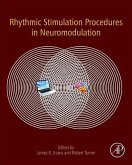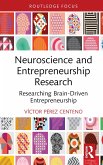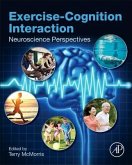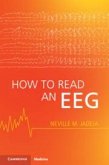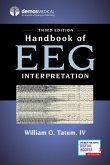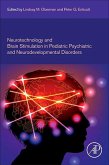Riitta Hari (Professor Emerita of Systems Neuroscience and Neuroima, Aina Puce (Eleanor Cox Riggs Professor Eleanor Cox Riggs Professor
Meg-Eeg Primer
Riitta Hari (Professor Emerita of Systems Neuroscience and Neuroima, Aina Puce (Eleanor Cox Riggs Professor Eleanor Cox Riggs Professor
Meg-Eeg Primer
- Broschiertes Buch
- Merkliste
- Auf die Merkliste
- Bewerten Bewerten
- Teilen
- Produkt teilen
- Produkterinnerung
- Produkterinnerung
MEG-EEG Primer is the first-ever volume to introduce and discuss MEG and EEG in a balanced manner side-by-side, starting from their physical and physiological bases and then advancing to methods of data acquisition, analysis, visualization, and interpretation. The authors pay special attention to careful experimentation, guiding readers to differentiate brain signals from various artifacts and to assure that the collected data are reliable. The book weighs thestrengths and weaknesses of MEG and EEG relative to one another and to other methods used in systems, cognitive, and social…mehr
Andere Kunden interessierten sich auch für
![Rhythmic Stimulation Procedures in Neuromodulation Rhythmic Stimulation Procedures in Neuromodulation]() Rhythmic Stimulation Procedures in Neuromodulation110,99 €
Rhythmic Stimulation Procedures in Neuromodulation110,99 €![Neuroscience and Entrepreneurship Research Neuroscience and Entrepreneurship Research]() Víctor Pérez CentenoNeuroscience and Entrepreneurship Research51,99 €
Víctor Pérez CentenoNeuroscience and Entrepreneurship Research51,99 €![Year One of Practice Transition Year One of Practice Transition]() Year One of Practice Transition164,99 €
Year One of Practice Transition164,99 €![Exercise-Cognition Interaction Exercise-Cognition Interaction]() Exercise-Cognition Interaction137,99 €
Exercise-Cognition Interaction137,99 €![How to Read an EEG How to Read an EEG]() Neville M. JadejaHow to Read an EEG58,99 €
Neville M. JadejaHow to Read an EEG58,99 €![Handbook of Eeg Interpretation Handbook of Eeg Interpretation]() Tatum, William O., IVHandbook of Eeg Interpretation91,99 €
Tatum, William O., IVHandbook of Eeg Interpretation91,99 €![Neurotechnology and Brain Stimulation in Pediatric Psychiatric and Neurodevelopmental Disorders Neurotechnology and Brain Stimulation in Pediatric Psychiatric and Neurodevelopmental Disorders]() Neurotechnology and Brain Stimulation in Pediatric Psychiatric and Neurodevelopmental Disorders147,99 €
Neurotechnology and Brain Stimulation in Pediatric Psychiatric and Neurodevelopmental Disorders147,99 €-
-
-
MEG-EEG Primer is the first-ever volume to introduce and discuss MEG and EEG in a balanced manner side-by-side, starting from their physical and physiological bases and then advancing to methods of data acquisition, analysis, visualization, and interpretation. The authors pay special attention to careful experimentation, guiding readers to differentiate brain signals from various artifacts and to assure that the collected data are reliable. The book weighs thestrengths and weaknesses of MEG and EEG relative to one another and to other methods used in systems, cognitive, and social neuroscience. The authors also discuss the role of MEG and EEG in the assessment of brain function in various clinical disorders. The book aims to bring members of multidisciplinaryresearch teams onto equal footing so that they can contribute to different aspects of MEG and EEG research and to be able to participate in future developments in the field.
Hinweis: Dieser Artikel kann nur an eine deutsche Lieferadresse ausgeliefert werden.
Hinweis: Dieser Artikel kann nur an eine deutsche Lieferadresse ausgeliefert werden.
Produktdetails
- Produktdetails
- Verlag: Oxford University Press Inc
- Seitenzahl: 348
- Erscheinungstermin: 25. April 2017
- Englisch
- Abmessung: 251mm x 177mm x 20mm
- Gewicht: 724g
- ISBN-13: 9780190497774
- ISBN-10: 0190497777
- Artikelnr.: 47867959
- Herstellerkennzeichnung
- Libri GmbH
- Europaallee 1
- 36244 Bad Hersfeld
- gpsr@libri.de
- Verlag: Oxford University Press Inc
- Seitenzahl: 348
- Erscheinungstermin: 25. April 2017
- Englisch
- Abmessung: 251mm x 177mm x 20mm
- Gewicht: 724g
- ISBN-13: 9780190497774
- ISBN-10: 0190497777
- Artikelnr.: 47867959
- Herstellerkennzeichnung
- Libri GmbH
- Europaallee 1
- 36244 Bad Hersfeld
- gpsr@libri.de
Riitta Hari MD, PhD researches systems neuroscience and neuroimaging. She has pioneered the use of MEG in the study of the spatiotemporal dynamics of sensory, motor, cognitive and social brain functions both in health and disease. Her background training is in medicine, with specialization in clinical neurophysiology. Aina Puce, PhD is a social neuroscientist with research interests in the brain bases of human non-verbal communication. Her studies in basic and clinical human neuroscience have used scalp and intracranial EEG, and functional MRI methods. Her formal training was in biophysics and functional brain mapping/neurophysiology.
* PREFACE
* PREAMBLE
* SECTION 1
* CHAPTER 1: INTRODUCTION
* MEG and EEG Setups
* Comparison of MEG and EEG
* Structure of this Primer
* CHAPTER 2: INSIGHTS INTO THE HUMAN BRAIN
* Overview of the Human Brain
* How to Obtain Information About Brain Function
* Timing in Human Behavior
* Functional Structure of the Human Cerebral Cortex
* Communication Between Brain Areas
* Thalamocortical Connections
* Intra-Brain Connectivity
* Electric Signaling in Neurons
* Membrane Potential
* Action Potentials
* Postsynaptic Potentials
* CHAPTER 3: BASIC PHYSICS AND PHYSIOLOGY OF MEG AND EEG
* An Overview of MEG and EEG Signal Generation
* Charges and Electric Current
* Ohm's and Kirchoff's Laws
* Relationship Between Current and Magnetic Field
* Superconductivity
* Inverse Problem
* Source Currents
* Primary Current
* Layers, Open Fields, and Closed Fields
* Intracortical Cancellation
* Volume Conduction
* Spherical Head Model
* Some General Points About Source Localization
* CHAPTER 4: AN OVERVIEW OF EEG AND MEG
* Historical Aspects
* Early EEG Recordings
* Early MEG Recordings
* Brain Rhythms
* Evoked and Event-Related Responses
* SECTION 2
* CHAPTER 5: INSTRUMENTATION FOR MEG AND EEG
* EEG Instrumentation
* Electrodes
* EEG Amplifiers
* Differential Amplifiers, Common Mode Rejection, and Amplifier Input
Impedances
* Standard Electrode Positions
* Effects of Reference Electrode on Potential Distribution
* Re-Referencing Relative to an Average Reference
* MEG Instrumentation
* Squids and Squid Electronics
* Flux Transformers and Their Configuration
* Shielding
* Other Means to Maintain a Noise-Free Environment
* Stimulators and Monitoring Devices
* Auditory Stimulators
* Visual Stimulators
* Somatosensory Stimulators
* Stimulators for Inducing Acute Pain
* Passive-Movement Stimulators (Proprioception Stimulation)
* Monitoring Devices
* Future Developments of EEG and MEG Instrumentation
* Developments in EEG
* Developments in MEG
* CHAPTER 6. PRACTICALITIES OF DATA COLLECTION
* General Principles of Good Experimentation
* Replicability Checks
* EEG Recordings: The Practice
* Electrodes, Skin Preparation, and Electrode-Impedance Measurement
* Post-Recording Infection Control
* MEG Recordings: The Practice
* Measurement of MEG Sensor and EEG Electrode Positions
* Locations of MEG Sensors and EEG Electrodes
* Electrical Safety
* CHAPTER 7: DATA ACQUISITION AND PREPROCESSING
* Filtering
* Data Sampling (Analog-To-Digital Conversion)
* CHAPTER 8: ARTIFACTS
* General
* Artifact-Removal Methods
* Blind Source Separation and Independent-Component Analysis
* Signal-Space Projection (SSP) and Temporal Signal-Space Separation
Tsss (For MEG)
* Eye-Related Artifacts
* Generation and Recognition of Eye Movement and Eye Blink Artifacts
* Saccadic and Microsaccade Artifacts
* Electroretinogram and Magnetoretinogram
* Removal of Eye-Related Artifacts
* Muscle Artifacts
* Generation and Recognition
* Removal
* Cardiac Artifacts
* Generation and Recognition
* Removal
* Respiration-Related Artifacts
* Generation and Recognition
* Sweating
* Generation, Recognition, and Removal
* Non-Physiological Artifacts
* Power-Line Noise and its Removal
* Response-Box Artifacts
* EEG-Electrode and MEG-Sensor-Related Artifacts
* How to be Sure that the Signals come from the Brain
* CHAPTER 9: ANALYZING THE DATA
* General
* Data Inspection and Pre-Processing
* Signal Averaging of MEG/EEG Data
* Signal-To-Noise Considerations
* Segmentation
* Amplitude and Latency Measures
* Issues Related to Cross-Group Averaging and Assessment of Group
Differences
* Topographic Maps of EEG and MEG Activity
* Whole-Head Statistical Analysis of EEG Data
* Analysis of Spontaneous Activity and Single-Trial Data
* General
* Evoked Versus Induced Activity
* MEG/EEG Signal Level and Power
* Event-Related Desynchronization and Synchronization, and Temporal
Spectral Evolution
* Time-Frequency Analyses
* Phase Resetting and Models of Evoked Activity
* Coherence and Other Measures of Association
* Cross-Frequency Coupling
* Global Field Power, Dissimilarity, and Brain Microstates
* Source Modeling
* The Forward and Inverse Problems in MEG and EEG
* Head Models
* Single-Dipole Model and Model Validity
* Goodness-of-Fit and Confidence Limits of the Model
* Spatial Resolution
* Source Extent
* Multidipole Models, Distributed Models, and Beamformers
* Hypothesis Testing with Predetermined Source Locations
* Effect of Synchrony
* Changes in Orientation/Tilting
* Assessments of Effective Connectivity
* Common Pitfalls in Data Analysis and Interpretation
* Interpretation of MEG/EEG Data
* SECTION 3
* CHAPTER 10: BRAIN RHYTHMS
* General
* Alpha Rhythm of the Posterior Cortex
* Mu Rhythm of the Sensorimotor Cortex
* Tau Rhythm in the Auditory Cortex
* Beta Rhythm
* Theta Rhythm
* Gamma Rhythms
* Delta-Band Activity and Ultra-Slow Oscillations
* Coupling Between Different Brain Rhythms
* Changes in Brain Rhythms During Sleep
* Effects of Anesthesia and Other Drugs on EEG/MEG
* CHAPTER 11: EVOKED AND EVENT-RELATED RESPONSES
* General
* An Initial Example
* Nomenclature of Evoked Responses and Brain Rhythms
* Effects of Interstimulus Interval and Stimulus Timing
* Effects of Other Stimulus Parameters
* CHAPTER 12: AUDITORY RESPONSES
* Aspects of Auditory Stimulation
* Auditory Brainstem Responses
* Middle-Latency Auditory-Evoked Responses
* Long-Latency Auditory Evoked Responses
* Auditory Steady-State Responses
* Frequency Tagging
* CHAPTER 13: VISUAL RESPONSES
* Visual Stimuli
* Transient Visual Responses
* Assessing the Ventral Visual Stream
* Assessing the Dorsal Visual Stream
* Steady-State Visual Responses
* CHAPTER 14: SOMATOSENSORY RESPONSES 304
* Compound Action Potentials and Fields of Peripheral Nerves
* Responses from SI Cortex
* Responses from Posterior Parietal Cortex
* Responses from SII Cortex
* Somatosensory Steady-State Responses
* High-Frequency Oscillations (Hfos) in SI
* Pain and Nociceptive Responses
* CHAPTER 15: OTHER SENSORY RESPONSES and MULTISENSORY INTERACTIONS
* Visceral Responses
* Olfactory and Gustatory Responses
* Multisensory Interaction
* General
* Audiotactile Interaction: An MEG Case Study
* Multisensory Integration of Human Communication
* Multisensory Integration Reflected in Spontaneous MEG/EEG Activity
* CHAPTER 16: MOTOR FUNCTION
* Movement-Related Readiness Potentials and Fields
* Coherence Between Brain Activity and Movements/Muscles
* General
* Cortex-Muscle Coherence
* Corticokinematic Coherence
* Corticovocal Coherence
* CHAPTER 17: BRAIN SIGNALS RELATED TO CHANGE DETECTION
* General
* Contingent Negative Variation (CNV)
* Mismatch Negativity and Field (MMN, MMF)
* P300 Responses
* N400 Responses
* Error-Related Negativity (ERN)
* CHAPTER 18: THE SOCIAL BRAIN
* Theoretical Framework
* Responses to Emotions Depicted by Faces and Bodies
* Action Viewing and Mirroring
* Hyperscanning
* Verbal Communication
* CHAPTER 19: BRAIN DISORDERS
* General Remarks
* Epilepsy
* Preoperative Mapping
* Functional Identification of the Central Sulcus
* Anatomical Identification of the Central Sulcus
* Hemispheric Dominance for Speech and Language
* Stroke
* Critically Ill Patients
* Coma
* Brain Death
* CHAPTER 20: MEG/EEG IN THE STUDY OF BRAIN FUNCTION
* Advantages of MEG and EEG
* Disadvantages of MEG and EEG
* Combining MEG and EEG
* Combining MEG/EEG with MRI/fMRI
* EEG During Non-Invasive Brain Stimulation
* CHAPTER 21: LOOKING TO THE FUTURE
* Decoding of Brain States
* Travelling Light
* Data Governance
* Better Analysis of Behavior
* Modeling at Different Levels
* How Your MEG and EEG Work Can Make an Impact on Science
* Index
* PREAMBLE
* SECTION 1
* CHAPTER 1: INTRODUCTION
* MEG and EEG Setups
* Comparison of MEG and EEG
* Structure of this Primer
* CHAPTER 2: INSIGHTS INTO THE HUMAN BRAIN
* Overview of the Human Brain
* How to Obtain Information About Brain Function
* Timing in Human Behavior
* Functional Structure of the Human Cerebral Cortex
* Communication Between Brain Areas
* Thalamocortical Connections
* Intra-Brain Connectivity
* Electric Signaling in Neurons
* Membrane Potential
* Action Potentials
* Postsynaptic Potentials
* CHAPTER 3: BASIC PHYSICS AND PHYSIOLOGY OF MEG AND EEG
* An Overview of MEG and EEG Signal Generation
* Charges and Electric Current
* Ohm's and Kirchoff's Laws
* Relationship Between Current and Magnetic Field
* Superconductivity
* Inverse Problem
* Source Currents
* Primary Current
* Layers, Open Fields, and Closed Fields
* Intracortical Cancellation
* Volume Conduction
* Spherical Head Model
* Some General Points About Source Localization
* CHAPTER 4: AN OVERVIEW OF EEG AND MEG
* Historical Aspects
* Early EEG Recordings
* Early MEG Recordings
* Brain Rhythms
* Evoked and Event-Related Responses
* SECTION 2
* CHAPTER 5: INSTRUMENTATION FOR MEG AND EEG
* EEG Instrumentation
* Electrodes
* EEG Amplifiers
* Differential Amplifiers, Common Mode Rejection, and Amplifier Input
Impedances
* Standard Electrode Positions
* Effects of Reference Electrode on Potential Distribution
* Re-Referencing Relative to an Average Reference
* MEG Instrumentation
* Squids and Squid Electronics
* Flux Transformers and Their Configuration
* Shielding
* Other Means to Maintain a Noise-Free Environment
* Stimulators and Monitoring Devices
* Auditory Stimulators
* Visual Stimulators
* Somatosensory Stimulators
* Stimulators for Inducing Acute Pain
* Passive-Movement Stimulators (Proprioception Stimulation)
* Monitoring Devices
* Future Developments of EEG and MEG Instrumentation
* Developments in EEG
* Developments in MEG
* CHAPTER 6. PRACTICALITIES OF DATA COLLECTION
* General Principles of Good Experimentation
* Replicability Checks
* EEG Recordings: The Practice
* Electrodes, Skin Preparation, and Electrode-Impedance Measurement
* Post-Recording Infection Control
* MEG Recordings: The Practice
* Measurement of MEG Sensor and EEG Electrode Positions
* Locations of MEG Sensors and EEG Electrodes
* Electrical Safety
* CHAPTER 7: DATA ACQUISITION AND PREPROCESSING
* Filtering
* Data Sampling (Analog-To-Digital Conversion)
* CHAPTER 8: ARTIFACTS
* General
* Artifact-Removal Methods
* Blind Source Separation and Independent-Component Analysis
* Signal-Space Projection (SSP) and Temporal Signal-Space Separation
Tsss (For MEG)
* Eye-Related Artifacts
* Generation and Recognition of Eye Movement and Eye Blink Artifacts
* Saccadic and Microsaccade Artifacts
* Electroretinogram and Magnetoretinogram
* Removal of Eye-Related Artifacts
* Muscle Artifacts
* Generation and Recognition
* Removal
* Cardiac Artifacts
* Generation and Recognition
* Removal
* Respiration-Related Artifacts
* Generation and Recognition
* Sweating
* Generation, Recognition, and Removal
* Non-Physiological Artifacts
* Power-Line Noise and its Removal
* Response-Box Artifacts
* EEG-Electrode and MEG-Sensor-Related Artifacts
* How to be Sure that the Signals come from the Brain
* CHAPTER 9: ANALYZING THE DATA
* General
* Data Inspection and Pre-Processing
* Signal Averaging of MEG/EEG Data
* Signal-To-Noise Considerations
* Segmentation
* Amplitude and Latency Measures
* Issues Related to Cross-Group Averaging and Assessment of Group
Differences
* Topographic Maps of EEG and MEG Activity
* Whole-Head Statistical Analysis of EEG Data
* Analysis of Spontaneous Activity and Single-Trial Data
* General
* Evoked Versus Induced Activity
* MEG/EEG Signal Level and Power
* Event-Related Desynchronization and Synchronization, and Temporal
Spectral Evolution
* Time-Frequency Analyses
* Phase Resetting and Models of Evoked Activity
* Coherence and Other Measures of Association
* Cross-Frequency Coupling
* Global Field Power, Dissimilarity, and Brain Microstates
* Source Modeling
* The Forward and Inverse Problems in MEG and EEG
* Head Models
* Single-Dipole Model and Model Validity
* Goodness-of-Fit and Confidence Limits of the Model
* Spatial Resolution
* Source Extent
* Multidipole Models, Distributed Models, and Beamformers
* Hypothesis Testing with Predetermined Source Locations
* Effect of Synchrony
* Changes in Orientation/Tilting
* Assessments of Effective Connectivity
* Common Pitfalls in Data Analysis and Interpretation
* Interpretation of MEG/EEG Data
* SECTION 3
* CHAPTER 10: BRAIN RHYTHMS
* General
* Alpha Rhythm of the Posterior Cortex
* Mu Rhythm of the Sensorimotor Cortex
* Tau Rhythm in the Auditory Cortex
* Beta Rhythm
* Theta Rhythm
* Gamma Rhythms
* Delta-Band Activity and Ultra-Slow Oscillations
* Coupling Between Different Brain Rhythms
* Changes in Brain Rhythms During Sleep
* Effects of Anesthesia and Other Drugs on EEG/MEG
* CHAPTER 11: EVOKED AND EVENT-RELATED RESPONSES
* General
* An Initial Example
* Nomenclature of Evoked Responses and Brain Rhythms
* Effects of Interstimulus Interval and Stimulus Timing
* Effects of Other Stimulus Parameters
* CHAPTER 12: AUDITORY RESPONSES
* Aspects of Auditory Stimulation
* Auditory Brainstem Responses
* Middle-Latency Auditory-Evoked Responses
* Long-Latency Auditory Evoked Responses
* Auditory Steady-State Responses
* Frequency Tagging
* CHAPTER 13: VISUAL RESPONSES
* Visual Stimuli
* Transient Visual Responses
* Assessing the Ventral Visual Stream
* Assessing the Dorsal Visual Stream
* Steady-State Visual Responses
* CHAPTER 14: SOMATOSENSORY RESPONSES 304
* Compound Action Potentials and Fields of Peripheral Nerves
* Responses from SI Cortex
* Responses from Posterior Parietal Cortex
* Responses from SII Cortex
* Somatosensory Steady-State Responses
* High-Frequency Oscillations (Hfos) in SI
* Pain and Nociceptive Responses
* CHAPTER 15: OTHER SENSORY RESPONSES and MULTISENSORY INTERACTIONS
* Visceral Responses
* Olfactory and Gustatory Responses
* Multisensory Interaction
* General
* Audiotactile Interaction: An MEG Case Study
* Multisensory Integration of Human Communication
* Multisensory Integration Reflected in Spontaneous MEG/EEG Activity
* CHAPTER 16: MOTOR FUNCTION
* Movement-Related Readiness Potentials and Fields
* Coherence Between Brain Activity and Movements/Muscles
* General
* Cortex-Muscle Coherence
* Corticokinematic Coherence
* Corticovocal Coherence
* CHAPTER 17: BRAIN SIGNALS RELATED TO CHANGE DETECTION
* General
* Contingent Negative Variation (CNV)
* Mismatch Negativity and Field (MMN, MMF)
* P300 Responses
* N400 Responses
* Error-Related Negativity (ERN)
* CHAPTER 18: THE SOCIAL BRAIN
* Theoretical Framework
* Responses to Emotions Depicted by Faces and Bodies
* Action Viewing and Mirroring
* Hyperscanning
* Verbal Communication
* CHAPTER 19: BRAIN DISORDERS
* General Remarks
* Epilepsy
* Preoperative Mapping
* Functional Identification of the Central Sulcus
* Anatomical Identification of the Central Sulcus
* Hemispheric Dominance for Speech and Language
* Stroke
* Critically Ill Patients
* Coma
* Brain Death
* CHAPTER 20: MEG/EEG IN THE STUDY OF BRAIN FUNCTION
* Advantages of MEG and EEG
* Disadvantages of MEG and EEG
* Combining MEG and EEG
* Combining MEG/EEG with MRI/fMRI
* EEG During Non-Invasive Brain Stimulation
* CHAPTER 21: LOOKING TO THE FUTURE
* Decoding of Brain States
* Travelling Light
* Data Governance
* Better Analysis of Behavior
* Modeling at Different Levels
* How Your MEG and EEG Work Can Make an Impact on Science
* Index
* PREFACE
* PREAMBLE
* SECTION 1
* CHAPTER 1: INTRODUCTION
* MEG and EEG Setups
* Comparison of MEG and EEG
* Structure of this Primer
* CHAPTER 2: INSIGHTS INTO THE HUMAN BRAIN
* Overview of the Human Brain
* How to Obtain Information About Brain Function
* Timing in Human Behavior
* Functional Structure of the Human Cerebral Cortex
* Communication Between Brain Areas
* Thalamocortical Connections
* Intra-Brain Connectivity
* Electric Signaling in Neurons
* Membrane Potential
* Action Potentials
* Postsynaptic Potentials
* CHAPTER 3: BASIC PHYSICS AND PHYSIOLOGY OF MEG AND EEG
* An Overview of MEG and EEG Signal Generation
* Charges and Electric Current
* Ohm's and Kirchoff's Laws
* Relationship Between Current and Magnetic Field
* Superconductivity
* Inverse Problem
* Source Currents
* Primary Current
* Layers, Open Fields, and Closed Fields
* Intracortical Cancellation
* Volume Conduction
* Spherical Head Model
* Some General Points About Source Localization
* CHAPTER 4: AN OVERVIEW OF EEG AND MEG
* Historical Aspects
* Early EEG Recordings
* Early MEG Recordings
* Brain Rhythms
* Evoked and Event-Related Responses
* SECTION 2
* CHAPTER 5: INSTRUMENTATION FOR MEG AND EEG
* EEG Instrumentation
* Electrodes
* EEG Amplifiers
* Differential Amplifiers, Common Mode Rejection, and Amplifier Input
Impedances
* Standard Electrode Positions
* Effects of Reference Electrode on Potential Distribution
* Re-Referencing Relative to an Average Reference
* MEG Instrumentation
* Squids and Squid Electronics
* Flux Transformers and Their Configuration
* Shielding
* Other Means to Maintain a Noise-Free Environment
* Stimulators and Monitoring Devices
* Auditory Stimulators
* Visual Stimulators
* Somatosensory Stimulators
* Stimulators for Inducing Acute Pain
* Passive-Movement Stimulators (Proprioception Stimulation)
* Monitoring Devices
* Future Developments of EEG and MEG Instrumentation
* Developments in EEG
* Developments in MEG
* CHAPTER 6. PRACTICALITIES OF DATA COLLECTION
* General Principles of Good Experimentation
* Replicability Checks
* EEG Recordings: The Practice
* Electrodes, Skin Preparation, and Electrode-Impedance Measurement
* Post-Recording Infection Control
* MEG Recordings: The Practice
* Measurement of MEG Sensor and EEG Electrode Positions
* Locations of MEG Sensors and EEG Electrodes
* Electrical Safety
* CHAPTER 7: DATA ACQUISITION AND PREPROCESSING
* Filtering
* Data Sampling (Analog-To-Digital Conversion)
* CHAPTER 8: ARTIFACTS
* General
* Artifact-Removal Methods
* Blind Source Separation and Independent-Component Analysis
* Signal-Space Projection (SSP) and Temporal Signal-Space Separation
Tsss (For MEG)
* Eye-Related Artifacts
* Generation and Recognition of Eye Movement and Eye Blink Artifacts
* Saccadic and Microsaccade Artifacts
* Electroretinogram and Magnetoretinogram
* Removal of Eye-Related Artifacts
* Muscle Artifacts
* Generation and Recognition
* Removal
* Cardiac Artifacts
* Generation and Recognition
* Removal
* Respiration-Related Artifacts
* Generation and Recognition
* Sweating
* Generation, Recognition, and Removal
* Non-Physiological Artifacts
* Power-Line Noise and its Removal
* Response-Box Artifacts
* EEG-Electrode and MEG-Sensor-Related Artifacts
* How to be Sure that the Signals come from the Brain
* CHAPTER 9: ANALYZING THE DATA
* General
* Data Inspection and Pre-Processing
* Signal Averaging of MEG/EEG Data
* Signal-To-Noise Considerations
* Segmentation
* Amplitude and Latency Measures
* Issues Related to Cross-Group Averaging and Assessment of Group
Differences
* Topographic Maps of EEG and MEG Activity
* Whole-Head Statistical Analysis of EEG Data
* Analysis of Spontaneous Activity and Single-Trial Data
* General
* Evoked Versus Induced Activity
* MEG/EEG Signal Level and Power
* Event-Related Desynchronization and Synchronization, and Temporal
Spectral Evolution
* Time-Frequency Analyses
* Phase Resetting and Models of Evoked Activity
* Coherence and Other Measures of Association
* Cross-Frequency Coupling
* Global Field Power, Dissimilarity, and Brain Microstates
* Source Modeling
* The Forward and Inverse Problems in MEG and EEG
* Head Models
* Single-Dipole Model and Model Validity
* Goodness-of-Fit and Confidence Limits of the Model
* Spatial Resolution
* Source Extent
* Multidipole Models, Distributed Models, and Beamformers
* Hypothesis Testing with Predetermined Source Locations
* Effect of Synchrony
* Changes in Orientation/Tilting
* Assessments of Effective Connectivity
* Common Pitfalls in Data Analysis and Interpretation
* Interpretation of MEG/EEG Data
* SECTION 3
* CHAPTER 10: BRAIN RHYTHMS
* General
* Alpha Rhythm of the Posterior Cortex
* Mu Rhythm of the Sensorimotor Cortex
* Tau Rhythm in the Auditory Cortex
* Beta Rhythm
* Theta Rhythm
* Gamma Rhythms
* Delta-Band Activity and Ultra-Slow Oscillations
* Coupling Between Different Brain Rhythms
* Changes in Brain Rhythms During Sleep
* Effects of Anesthesia and Other Drugs on EEG/MEG
* CHAPTER 11: EVOKED AND EVENT-RELATED RESPONSES
* General
* An Initial Example
* Nomenclature of Evoked Responses and Brain Rhythms
* Effects of Interstimulus Interval and Stimulus Timing
* Effects of Other Stimulus Parameters
* CHAPTER 12: AUDITORY RESPONSES
* Aspects of Auditory Stimulation
* Auditory Brainstem Responses
* Middle-Latency Auditory-Evoked Responses
* Long-Latency Auditory Evoked Responses
* Auditory Steady-State Responses
* Frequency Tagging
* CHAPTER 13: VISUAL RESPONSES
* Visual Stimuli
* Transient Visual Responses
* Assessing the Ventral Visual Stream
* Assessing the Dorsal Visual Stream
* Steady-State Visual Responses
* CHAPTER 14: SOMATOSENSORY RESPONSES 304
* Compound Action Potentials and Fields of Peripheral Nerves
* Responses from SI Cortex
* Responses from Posterior Parietal Cortex
* Responses from SII Cortex
* Somatosensory Steady-State Responses
* High-Frequency Oscillations (Hfos) in SI
* Pain and Nociceptive Responses
* CHAPTER 15: OTHER SENSORY RESPONSES and MULTISENSORY INTERACTIONS
* Visceral Responses
* Olfactory and Gustatory Responses
* Multisensory Interaction
* General
* Audiotactile Interaction: An MEG Case Study
* Multisensory Integration of Human Communication
* Multisensory Integration Reflected in Spontaneous MEG/EEG Activity
* CHAPTER 16: MOTOR FUNCTION
* Movement-Related Readiness Potentials and Fields
* Coherence Between Brain Activity and Movements/Muscles
* General
* Cortex-Muscle Coherence
* Corticokinematic Coherence
* Corticovocal Coherence
* CHAPTER 17: BRAIN SIGNALS RELATED TO CHANGE DETECTION
* General
* Contingent Negative Variation (CNV)
* Mismatch Negativity and Field (MMN, MMF)
* P300 Responses
* N400 Responses
* Error-Related Negativity (ERN)
* CHAPTER 18: THE SOCIAL BRAIN
* Theoretical Framework
* Responses to Emotions Depicted by Faces and Bodies
* Action Viewing and Mirroring
* Hyperscanning
* Verbal Communication
* CHAPTER 19: BRAIN DISORDERS
* General Remarks
* Epilepsy
* Preoperative Mapping
* Functional Identification of the Central Sulcus
* Anatomical Identification of the Central Sulcus
* Hemispheric Dominance for Speech and Language
* Stroke
* Critically Ill Patients
* Coma
* Brain Death
* CHAPTER 20: MEG/EEG IN THE STUDY OF BRAIN FUNCTION
* Advantages of MEG and EEG
* Disadvantages of MEG and EEG
* Combining MEG and EEG
* Combining MEG/EEG with MRI/fMRI
* EEG During Non-Invasive Brain Stimulation
* CHAPTER 21: LOOKING TO THE FUTURE
* Decoding of Brain States
* Travelling Light
* Data Governance
* Better Analysis of Behavior
* Modeling at Different Levels
* How Your MEG and EEG Work Can Make an Impact on Science
* Index
* PREAMBLE
* SECTION 1
* CHAPTER 1: INTRODUCTION
* MEG and EEG Setups
* Comparison of MEG and EEG
* Structure of this Primer
* CHAPTER 2: INSIGHTS INTO THE HUMAN BRAIN
* Overview of the Human Brain
* How to Obtain Information About Brain Function
* Timing in Human Behavior
* Functional Structure of the Human Cerebral Cortex
* Communication Between Brain Areas
* Thalamocortical Connections
* Intra-Brain Connectivity
* Electric Signaling in Neurons
* Membrane Potential
* Action Potentials
* Postsynaptic Potentials
* CHAPTER 3: BASIC PHYSICS AND PHYSIOLOGY OF MEG AND EEG
* An Overview of MEG and EEG Signal Generation
* Charges and Electric Current
* Ohm's and Kirchoff's Laws
* Relationship Between Current and Magnetic Field
* Superconductivity
* Inverse Problem
* Source Currents
* Primary Current
* Layers, Open Fields, and Closed Fields
* Intracortical Cancellation
* Volume Conduction
* Spherical Head Model
* Some General Points About Source Localization
* CHAPTER 4: AN OVERVIEW OF EEG AND MEG
* Historical Aspects
* Early EEG Recordings
* Early MEG Recordings
* Brain Rhythms
* Evoked and Event-Related Responses
* SECTION 2
* CHAPTER 5: INSTRUMENTATION FOR MEG AND EEG
* EEG Instrumentation
* Electrodes
* EEG Amplifiers
* Differential Amplifiers, Common Mode Rejection, and Amplifier Input
Impedances
* Standard Electrode Positions
* Effects of Reference Electrode on Potential Distribution
* Re-Referencing Relative to an Average Reference
* MEG Instrumentation
* Squids and Squid Electronics
* Flux Transformers and Their Configuration
* Shielding
* Other Means to Maintain a Noise-Free Environment
* Stimulators and Monitoring Devices
* Auditory Stimulators
* Visual Stimulators
* Somatosensory Stimulators
* Stimulators for Inducing Acute Pain
* Passive-Movement Stimulators (Proprioception Stimulation)
* Monitoring Devices
* Future Developments of EEG and MEG Instrumentation
* Developments in EEG
* Developments in MEG
* CHAPTER 6. PRACTICALITIES OF DATA COLLECTION
* General Principles of Good Experimentation
* Replicability Checks
* EEG Recordings: The Practice
* Electrodes, Skin Preparation, and Electrode-Impedance Measurement
* Post-Recording Infection Control
* MEG Recordings: The Practice
* Measurement of MEG Sensor and EEG Electrode Positions
* Locations of MEG Sensors and EEG Electrodes
* Electrical Safety
* CHAPTER 7: DATA ACQUISITION AND PREPROCESSING
* Filtering
* Data Sampling (Analog-To-Digital Conversion)
* CHAPTER 8: ARTIFACTS
* General
* Artifact-Removal Methods
* Blind Source Separation and Independent-Component Analysis
* Signal-Space Projection (SSP) and Temporal Signal-Space Separation
Tsss (For MEG)
* Eye-Related Artifacts
* Generation and Recognition of Eye Movement and Eye Blink Artifacts
* Saccadic and Microsaccade Artifacts
* Electroretinogram and Magnetoretinogram
* Removal of Eye-Related Artifacts
* Muscle Artifacts
* Generation and Recognition
* Removal
* Cardiac Artifacts
* Generation and Recognition
* Removal
* Respiration-Related Artifacts
* Generation and Recognition
* Sweating
* Generation, Recognition, and Removal
* Non-Physiological Artifacts
* Power-Line Noise and its Removal
* Response-Box Artifacts
* EEG-Electrode and MEG-Sensor-Related Artifacts
* How to be Sure that the Signals come from the Brain
* CHAPTER 9: ANALYZING THE DATA
* General
* Data Inspection and Pre-Processing
* Signal Averaging of MEG/EEG Data
* Signal-To-Noise Considerations
* Segmentation
* Amplitude and Latency Measures
* Issues Related to Cross-Group Averaging and Assessment of Group
Differences
* Topographic Maps of EEG and MEG Activity
* Whole-Head Statistical Analysis of EEG Data
* Analysis of Spontaneous Activity and Single-Trial Data
* General
* Evoked Versus Induced Activity
* MEG/EEG Signal Level and Power
* Event-Related Desynchronization and Synchronization, and Temporal
Spectral Evolution
* Time-Frequency Analyses
* Phase Resetting and Models of Evoked Activity
* Coherence and Other Measures of Association
* Cross-Frequency Coupling
* Global Field Power, Dissimilarity, and Brain Microstates
* Source Modeling
* The Forward and Inverse Problems in MEG and EEG
* Head Models
* Single-Dipole Model and Model Validity
* Goodness-of-Fit and Confidence Limits of the Model
* Spatial Resolution
* Source Extent
* Multidipole Models, Distributed Models, and Beamformers
* Hypothesis Testing with Predetermined Source Locations
* Effect of Synchrony
* Changes in Orientation/Tilting
* Assessments of Effective Connectivity
* Common Pitfalls in Data Analysis and Interpretation
* Interpretation of MEG/EEG Data
* SECTION 3
* CHAPTER 10: BRAIN RHYTHMS
* General
* Alpha Rhythm of the Posterior Cortex
* Mu Rhythm of the Sensorimotor Cortex
* Tau Rhythm in the Auditory Cortex
* Beta Rhythm
* Theta Rhythm
* Gamma Rhythms
* Delta-Band Activity and Ultra-Slow Oscillations
* Coupling Between Different Brain Rhythms
* Changes in Brain Rhythms During Sleep
* Effects of Anesthesia and Other Drugs on EEG/MEG
* CHAPTER 11: EVOKED AND EVENT-RELATED RESPONSES
* General
* An Initial Example
* Nomenclature of Evoked Responses and Brain Rhythms
* Effects of Interstimulus Interval and Stimulus Timing
* Effects of Other Stimulus Parameters
* CHAPTER 12: AUDITORY RESPONSES
* Aspects of Auditory Stimulation
* Auditory Brainstem Responses
* Middle-Latency Auditory-Evoked Responses
* Long-Latency Auditory Evoked Responses
* Auditory Steady-State Responses
* Frequency Tagging
* CHAPTER 13: VISUAL RESPONSES
* Visual Stimuli
* Transient Visual Responses
* Assessing the Ventral Visual Stream
* Assessing the Dorsal Visual Stream
* Steady-State Visual Responses
* CHAPTER 14: SOMATOSENSORY RESPONSES 304
* Compound Action Potentials and Fields of Peripheral Nerves
* Responses from SI Cortex
* Responses from Posterior Parietal Cortex
* Responses from SII Cortex
* Somatosensory Steady-State Responses
* High-Frequency Oscillations (Hfos) in SI
* Pain and Nociceptive Responses
* CHAPTER 15: OTHER SENSORY RESPONSES and MULTISENSORY INTERACTIONS
* Visceral Responses
* Olfactory and Gustatory Responses
* Multisensory Interaction
* General
* Audiotactile Interaction: An MEG Case Study
* Multisensory Integration of Human Communication
* Multisensory Integration Reflected in Spontaneous MEG/EEG Activity
* CHAPTER 16: MOTOR FUNCTION
* Movement-Related Readiness Potentials and Fields
* Coherence Between Brain Activity and Movements/Muscles
* General
* Cortex-Muscle Coherence
* Corticokinematic Coherence
* Corticovocal Coherence
* CHAPTER 17: BRAIN SIGNALS RELATED TO CHANGE DETECTION
* General
* Contingent Negative Variation (CNV)
* Mismatch Negativity and Field (MMN, MMF)
* P300 Responses
* N400 Responses
* Error-Related Negativity (ERN)
* CHAPTER 18: THE SOCIAL BRAIN
* Theoretical Framework
* Responses to Emotions Depicted by Faces and Bodies
* Action Viewing and Mirroring
* Hyperscanning
* Verbal Communication
* CHAPTER 19: BRAIN DISORDERS
* General Remarks
* Epilepsy
* Preoperative Mapping
* Functional Identification of the Central Sulcus
* Anatomical Identification of the Central Sulcus
* Hemispheric Dominance for Speech and Language
* Stroke
* Critically Ill Patients
* Coma
* Brain Death
* CHAPTER 20: MEG/EEG IN THE STUDY OF BRAIN FUNCTION
* Advantages of MEG and EEG
* Disadvantages of MEG and EEG
* Combining MEG and EEG
* Combining MEG/EEG with MRI/fMRI
* EEG During Non-Invasive Brain Stimulation
* CHAPTER 21: LOOKING TO THE FUTURE
* Decoding of Brain States
* Travelling Light
* Data Governance
* Better Analysis of Behavior
* Modeling at Different Levels
* How Your MEG and EEG Work Can Make an Impact on Science
* Index


